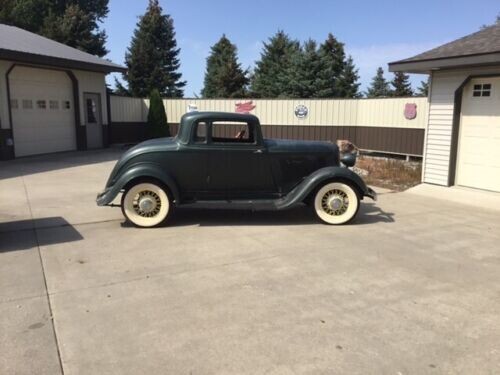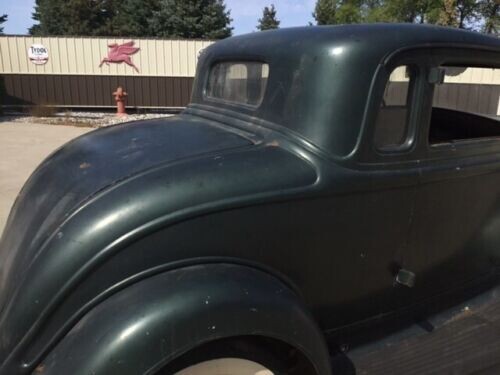People who are looking for a prewar car in the coupe body style almost always gravitate toward Ford products. While the Fords of the era have positive attributes such as good looks, parts availability, and club support going for them, they weren’t the best product being offered in the low-cost field. That honor would go to Walter P. Chrysler’s Plymouth. If you want proof, then take a look at this 1933 Plymouth coupe for sale on eBay in Hawley, Minnesota. Missing only a rear bumper and ready for restoration, this tidy Plymouth is looking for someone to refurbish it and enjoy its many attributes. At a current bit of $13,700, is this solid, rust-free car a bargain for someone who wants to drive and enjoy a prewar coupe?
The key to the claim that the Plymouth was a more advanced car than a Ford of similar vintage comes down to three things: brakes, engine, and engineering. From the time the first Plymouth rolled off the line in 1928, all of their cars boasted hydraulic brakes. We take that for granted now because they have been a given on every automobile sold in North America since 1946. In 1933, these were a relatively new concept even though Duesenberg introduced their use in racing and in their own Model A in 1921. Ford held out with mechanical brakes until 1938 at Henry Ford’s insistence. As the average speed of automobiles rose in concert with better road conditions, having a good set of brakes was becoming ever more important. Cars were also gaining weight and needed the mechanical advantage that hydraulic systems offered.
With that rise in weight came a need for more horsepower. The four-cylinder engine that Plymouth offered from 1928 through 1932 was an advanced unit in comparison to the competition’s fours. Ford’s first offering of a V-8 in addition to a four came in 1932. Chevrolet’s introduction of an inline six-cylinder, affectionately known as the “Stovebolt Six,” came in 1929. Walter Chrysler thus decided that Plymouth would have an inline six-cylinder of comparable displacement as well. The flathead six-cylinder that debuted in 1933 lasted until the early 1970s in agricultural use. This advanced engine with insert bearings instead of the usual Babbit type was continually developed as time went on. The excellent engineering of these engines allowed them to be used prolifically in countless military applications and Dodge Power Wagons until 1968. Loaded with low-end torque and utterly reliable, anyone purchasing a vehicle with one of those inline sixes can draw on a still plentiful parts supply and scores of used engine blocks and components.
Adding to the value that this new engine gave buyers, the Plymouth also boasted such features as helical-cut transmission gear, full instrumentation, and generous use of steel instead of wood in the body. Customers could order radios, a cigar liter, and various other options that weren’t commonly offered on low-priced cars. Fresh off the showroom floor, Plymouths were capable of an 80 MPH top speed and could even be ordered with a higher compression cylinder head for even more power.
The Plymouth you see here comes with little description in the ad. Plymouth had two series in 1933, the PC and the PD. The PC was the smaller model first introduced and received a lukewarm welcome from the public. By mid-year, Chrysler had raided Dodge’s parts bin and offered a car with a longer wheelbase and much more beautiful lines. The seller tells us that this coupe is complete minus a rear bumper. Another issue that may explain the reason for so few useable pictures is that the rear fender on the driver’s side has been removed for a minor repair. The engine will turn over, but the car will not run or drive at this point and has been sitting for some time. Despite living in Minnesota’s rough climate for decades, the car appears to be quite solid and ready for restoration. The wheels seem to have been restored and black primer adorns the straight body.
In the ad, the seller says that the car would be good to restore or make into a street rod. This car doesn’t need to be cut up to be a street rod. A knowledgeable engine man who is well versed in these engines can mix and match parts to give you an inline six that will push out over 120 horsepower and back it with an overdrive from a later Plymouth without cutting on anything other than the driveshaft. In a coupe this light, that is more than enough power to haul the mail. Combine that with the good brakes the car already has and you get a very handsome coupe that can eat up a lot of miles at highway speeds and do so reliably. In 1933, Plymouth was the second best-selling car in America, and they displaced Ford from that spot to do it. Buyers were wise then, and an equally wise buyer may end up with a great car if they choose this Plymouth to restore and enjoy in 2023.
Do you agree that Plymouth offered a better car in 1933? Please give us your thoughts and reasons in the comments.






As I was nothing but a future happening in 1933 I can’t comment on the prowess of Plymouth’s engineers. I can say that the cars have always been reliable tanks. I know because I hit a later model broadside and totaled my ’54 Chevy. Barely bent the left rear fender on the Plymouth. This is a good looking car and if you saw it on the road as a street rod you couldn’t tell it from a Ford. Fix up the mechanicals, paint it, and go have some fun with it.
Can’t help it, but I love these old cars. This is a good looking coupe, and back in the day, Plymouth was a great car.
My pops was born in ’33 and have always had a soft spot for any Mopars of that year – everyone has a Ford or Chevy.
When I get healthy enough to get back behind the wheel and build up my savings again, I’ll be hunting for one of these beauties.
You can bolt up a Mopar 3 speed transmission with the R-10 overdrive but the in 1933 the car had a floor shifter and the Mopar 3 speed with the R-10 was designed for use with a column shifter. It is not a simple bolt in conversion.
Nice looking car. Reminds me of my 32 Chevy.
My ’32 Chevy was also a good looker. Before I bought it I went to America and met the owner, I seem to remember his name was Pinkie Randall who had a picture of his 1912 Little in the book “Sixty years of Chevrolet” and a 1932 Chev Confederate like mine and he couldn’t believe that both cars were old time American but I had them in South Africa.
Nice car. I always wanted one like that. Left hand drive tho….lol
Please either restore or fix and use as-is. It would be tragic to corrupt such a great vehicle by hot-rodding it. These were wonderfully durable, practical cars, and proved to be mechanically indestructible.
Thank you for promoting restoration.
The name ‘Plymouth’ originated from Joseph W. Frazer, later of Kaiser-Frazer, to appeal to farmers who knew the brand from Plymouth Binder Twine.
120 hp in a stock engine was way ahead of its time, no need for a SBC! Great looking car as is, keep it that way buyer!
This is a great looking car as is. The factory low-slung roof looks like it’s already been lightly chopped. Smooth curves and not too much visual “laundry” tacked onto it. Super idea to tweak some more HP out of the engine, add an OD and go from there.
I love this car and wish I had some reason to buy it. Health, age, and distance is probably saving me from bidding. I’ve always been a car guy with mostly Mopars but never one this old. We had four Plymouth’s that I can think of with that six cylinder engine, 50 to 55 models, and I would like to have another one but I will have to pass on it for the reasons above. I hope the buyer just does what it needs to make it be a reliable driver and doesn’t do something silly like hot rodding it.
Some years ago when my Dad was still alive he used to tell a story of being stopped for a safety check. The cop would stand on the running board and hang on to the window frame telling the driver to get up to 20mph and slam on the brakes (most cars in those days had mechanical brakes) my dad did so in his Dodge and sent the cop flying to the ground. He thought he would be in trouble but instead the cop laughed and said you pass I forgot these cars have hydraulic brakes. In those days MOPAR did make good cars unfortunately they went to crap starting in the late 60’s with a bunch of Chinese plastic parts, thus their demise as an American car maker. Now owned by Stelantis (spelling probably wrong just like the junk they sell) and no longer an American car company. I’ll stick with my Fords for the time being.
God Bless America
All my Hondas were built in Ohio, supporting Americans.
A lot of the Fords are no longer built in the US… so tell me, which is better for Americans?? And a lot of my family was here when the Mayflower landed… so I’m plenty American.
And the money goes to Japan. No thanks.
“My Japanese car is all American.” The biggest red herring in the automotive world. I’ve been hearing that since Honda built that plant, to skirt the tariffs.
This is how my 34 Plymouth PF looked when I got finished. Certainly more stylish than a Ford and better built and I am a Ford guy.!!!!!!
Love it! Yellow makes it pop.
Nice.
These cars were so much better than the Ford’s of the era, that they’re rare as hens teeth.
Where did all of the 1933 & 1934 Dodge and Plymouths go? They were much stronger than the Ford and wooden bodied Chevrolets of that era, and when stock car racing took off in the post-war to early 1960s they were snapped up and made into stock cars. If you look at the early stock car racing film clips you will see early 30’s Mopars and later 30’s Fords (with juice brakes)make up most of the fields.
When race tracks opened in the south, and tracks were giving a few bucks for winning a race, these cars were sent into harms way. They started full bodied, but as the seaons went by, fenders were taken off, bumbers were gone for push bars, and motors replaced with more powerfull V8’s (flatheads). Thousands went to the scrap heap…it was a shame.
Had a ’34 Plymouth coupe when I was in high school. All stock except the paint. It was a lot of fun, wish I would have kept it. Sold it to a fella and he put a GTO engine in it, totaled it on his first drive. Made me ill..
This is a kick ass Plymouth coupe !!!
Great find !!
Great cars i had a 1934 PE 2-door Sendan. nice car